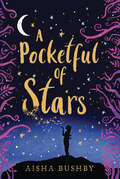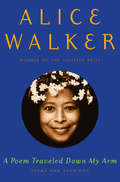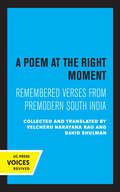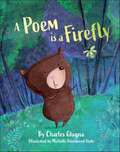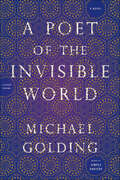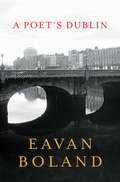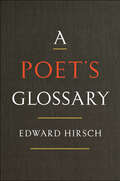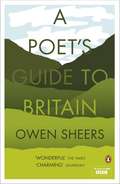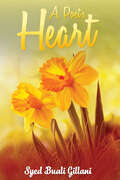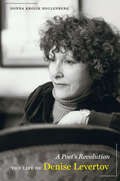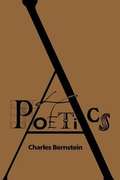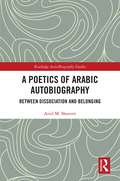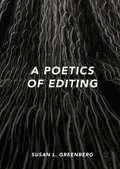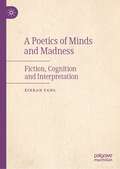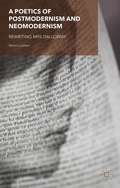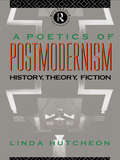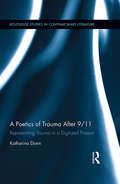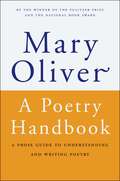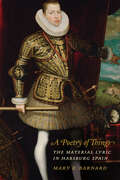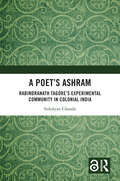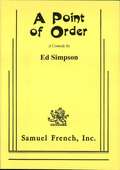- Table View
- List View
A Pocketful of Stars
by Aisha BushbySafiya and her mother have never seen eye to eye. Her mother doesn't understand Safiya's love of gaming, and shy Safiya doesn't think she has anything in common with her vibrant, sometimes volatile mother. But when her mother falls into a coma, Safiya's whole world shifts. She finds herself dreaming about an unfamiliar setting and a rebellious girl who's distinctly familiar... As Safiya unlocks the secrets of these dreams the way she would unlock levels in a game, she realizes that opening her heart to the past is the key to changing her future—and that she may not be so different from her mother after all.
A Poem Traveled Down My Arm: Poems and Drawings
by Alice WalkerIn this illuminating book, Pulitzer Prize–winning novelist and acclaimed poet Alice Walker reveals her remarkable philosophy of life. Curiously, this labor of love started with the author’s signature: Faced with the daunting task of providing autographs for multiple copies of one of her poetry collections, Absolute Trust in the Goodness of the Earth, Walker turned an act of repetition into an act of inspiration. For each autograph became something more than a name: a thoughtful reflection, an impromptu sketch, a heartfelt poem. The result is this spontaneous burst of the unexpected. A Poem Traveled Down My Arm is a lovely collection of insights and drawings—by turns charming and humorous, provocative and profound—that represent the wisdom of one of today’s most beloved writers. The essence of Walker’s independent spirit emanates from words and images that are simple but deep in meaning. An empowering approach to life. . . the inspiration to live completely in the moment. . . the chance to nurture one’s creativity and peace of mind—all these beautiful elements are evoked by this unusual and original book.
A Poem at the Right Moment: Remembered Verses from Premodern South India (Voices from Asia #10)
by David Shulman Narayana Rao VelcheruA Poem at the Right Moment collects, and preserves, poems—called catus—that have circulated orally for centuries in South India. The poems are remarkable for their wit and precision, their lyrical insight on the commonplace, their fascination with sensual experience, and their exploration of the connection between language and desire. Taken together the catus offer a penetrating critical vision and an understanding of the classical traditions of Telugu, Tamil, and Sanskrit. Each poem is presented in a contemporary English translation along with the Indian-language original. An introduction and a concluding essay explore in detail the stories and texts that comprise the catu system. This title is part of UC Press's Voices Revived program, which commemorates University of California Press’s mission to seek out and cultivate the brightest minds and give them voice, reach, and impact. Drawing on a backlist dating to 1893, Voices Revived makes high-quality, peer-reviewed scholarship accessible once again using print-on-demand technology. This title was originally published in 1998.
A Poem for Grandma (Leveled Readers 4.4.4)
by Andrew ClementsAn extremely shy young girl overcomes her shyness and reads one of her poems to an audience.
A Poem in Your Pocket (Mr. Tiffin's Classroom Series)
by G. Brian Karas Margaret McnamaraUsher in National Poetry Month with Mr. Tiffin and his students, stars of the hugely popular How Many Seeds in a Pumpkin? and The Apple Orchard Riddle. Once again, Margaret McNamara sets her playful, child-friendly story in the classroom, and this time, poetry--from metaphors to acrostics to haiku--is the name of the game. The focus here is on Elinor, whose confidence falters as she tries to write something "perfect" for Poem in Your Pocket Day and impress a visiting poet. G. Brian Karas's accessible, adorable illustrations add to the fun.Includes a list of Mr. Tiffin's tips for celebrating Poem in Your Pocket Day.From the Hardcover edition.
A Poem is a Firefly
by Charles GhignaFather Goose®, author Charles Ghigna, introduces poetry to children through the eyes of an adorable bear, his woodland friends, and a bright little firefly. What is a poem? A poem can be many things. In this sweet forest setting join a group of friendly woodland animals as they ponder the wonder and magic of poetry. Each animal friend offers their own ideas about poetry, from a whisper to a shout to a laugh to a sigh, and then realizes that poetry is an everyday part of our lives. And yes, indeed, a poem can be a firefly upon the summer wind. Young readers will discover that a poem can be many things, such as a moment or a memory caught in time. Winner of the Northern Lights Book Awards Winner, Poetry Category, A Poem Is a Firefly is an ideal way to get children thinking about literature and is a perfect introduction to the genre of poetry.
A Poet of the Invisible World: A Novel
by Michael GoldingIn the tradition of SIDDHARTHA by Hermann Hesse comes a new spiritual novel that is a stunning feat of storytelling and imagination. A Poet of the Invisible World follows a boy named Nouri, born in thirteenth-century Persia, with four ears instead of two. Orphaned as an infant, he's taken into a Sufi order, where he meets an assortment of dervishes and is placed upon a path toward spiritual awakening. As he stumbles from one painful experience to the next, he grows into manhood. Each trial he endures shatters another obstacle within--and leads Nouri on toward transcendence.
A Poet's Dublin
by Eavan BolandJuxtaposing verse and image, A Poet's Dublin is a study of origin and influence from "a major Irish poet" (Edward Hirsch). Written over years, the transcendent and moving poems in A Poet's Dublin seek out shadows and impressions of a powerful, historic city, studying how it forms and alters language, memory, and selfhood. The poems range from an evocation of the neighborhoods under the hills where the poet lived and raised her children to the inner-city bombing of 1974, and include such signature poems as "The Pomegranate," "The War Horse," and "Anna Liffey." Above all, these poems weave together the story of a self and a city--private, political, and bound by history. The poems are supported by photographs of the city at all times and in all seasons: from dawn on the river Liffey, which flows through Dublin, to twilight up in the Dublin foothills.
A Poet's Glossary
by Edward HirschA major addition to the literature of poetry, Edward Hirsch’s sparkling new work is a compilation of forms, devices, groups, movements, isms, aesthetics, rhetorical terms, and folklore—a book that all readers, writers, teachers, and students of poetry will return to over and over. Hirsch has delved deeply into the poetic traditions of the world, returning with an inclusive, international compendium. Moving gracefully from the bards of ancient Greece to the revolutionaries of Latin America, from small formal elements to large mysteries, he provides thoughtful definitions for the most important poetic vocabulary, imbuing his work with a lifetime of scholarship and the warmth of a man devoted to his art.Knowing how a poem works is essential to unlocking its meaning. Hirsch’s entries will deepen readers’ relationships with their favorite poems and open greater levels of understanding in each new poem they encounter. Shot through with the enthusiasm, authority, and sheer delight that made How to Read a Poem so beloved, A Poet’s Glossary is a new classic.
A Poet's Guide to Britain
by Owen SheersIntroduced and selected by the poet-presenter Owen Sheers, A Poet's Guide to Britain is a major poetry anthology that ties in with the BBC series of the same name.Owen Sheers passionately believes that poems, and particularly poems of place, not only affect us as individuals, but can have the power to mark and define a collective experience - our identities, our country, our land. He has chosen six powerful poems, all personal favourites, and all poems that have become part of the way we see our landscape. The anthology follows a similar format to the BBC series itself, while also offering paper chains of poems about the landscape and nature of Britain, transcripts of contemporary poet interviews, and a short introduction to each lead poem.
A Poet's Heart
by Syed Buali GillaniLies of nightIf the tip of a sun doesn’t wash your ink away,Then your eye has sinned throw that lamp away,This darkness like a sigh is the sight of an eye,With the rise of a sun comes the news of a night,That which will give a raging fever to your art,For years has to burn like a flame in your heart,Every wood brings change when placed in a pyre,Happy or sad it’s bewildered by a fire,Filled with memories are your empty eyes,Full of life but your spirit has died,A night always comes with a dagger in one hand,For those happy boarders of a joyful land,The fire of love burns in those parts of hell,Where windows of heaven open to drizzle her smell,And If god lives in heart or so says the Christian man,Then when a heart is broken does he feel the pain?I wrote this poem in fear that should a day come where I have to write a synopsis for this book what will I say? Well, this short poem truly encapsulates my story, words, sentences, and paragraphs don’t do justice to art, so “Let the rise of sun be the proof of sun”. Poetry has burnt within me for years. This book is about that fire, I believe every single person in the world has an interesting story to tell, but not all can tell an interesting story. Then there are those stories that are both interesting and intense, those stories are really worth telling. While a neurotic can choke on his own intensity, an artist makes a story out of the flesh of his madness. There is not a lot of difference between the two, except the latter is somehow penetrable.
A Poet's Revolution
by Donna HollenbergThis first full-length biography of Anglo- American poet and activist Denise Levertov (1923-1997) brings to life one of the major voices of the second half of the twentieth century, when American poetry was a powerful influence worldwide. Drawing on exhaustive archival research and interviews with 75 friends of Levertov, as well as on Levertov's entire opus, Donna Krolik Hollenberg's authoritative biography captures the full complexity of Levertov as both woman and artist, and the dynamic world she inhabited. She charts Levertov's early life in England as the daughter of a Russian Hasidic father and a Welsh mother, her experience as a nurse in London during WWII, her marriage to an American after the war, and her move to New York City where she became a major figure in the American poetry scene. The author chronicles Levertov's role as a passionate social activist in volatile times and her importance as a teacher of writing. Finally, Hollenberg shows how the spiritual dimension of Levertov's poetry deepened toward the end of her life, so that her final volumes link lyric perception with political and religious commitment.
A Poetics
by Charles BernsteinThis collection is considered to be more than a work of criticism by the poet Charles Bernstein, it is a poetic intervention into criticism. Artifice of Absorption, a key essay, is written in verse, and its structures and rhythms initiate the reader into the strength and complexity of the argument.
A Poetics of Arabic Autobiography: Between Dissociation and Belonging (Routledge Auto/Biography Studies)
by Ariel M. SheetritThis book examines the poetics of autobiographical masterpieces written in Arabic by Leila Abouzeid, Hanan al-Shaykh, Samuel Shimon, Abd al-Rahman Munif, Salim Barakat, Mohamed Choukri and Hanna Abu Hanna. These literary works articulate the life story of each author in ways that undermine the expectation that the "self"—the "auto" of autobiography—would be the dominant narrative focus. Although every autobiography naturally includes and relates to others to one degree or another, these autobiographies tend to foreground other characters, voices, places and texts to the extent that at times it appears as though the autobiographical subject has dropped out of sight, even to the point of raising the question: is this an autobiography? These are indeed autobiographies, Sheetrit argues, albeit articulating the story of the self in unconventional ways. Sheetrit offers in-depth literary studies that expose each text’s distinct strategy for life narrative. Crucial to this book’s approach is the innovative theoretical foundation of relational autobiography that reveals the grounding of the self within the collective—not as symbolic of it. This framework exposes the intersection of the story of the autobiographical subject with the stories of others and the tensions between personal and communal discourse. Relational strategies for self-representation expose a movement between two seemingly opposing desires—the desire to separate and dissociate from others, and the desire to engage and integrate within a particular relationship, community, culture or milieu. This interplay between disentangling and conscious entangling constitutes the leitmotif that unites the studies in this book.
A Poetics of Editing
by Susan L. GreenbergThis original and authoritative book offers a first-ever attempt to define a poetics of the editing arts. It proposes a new field of editing studies, in which the ‘ideal editor’ can be understood in relation to the long-theorised author and reader. The book’s premise is that editing, like other forms of ‘making’, is mostly invisible and can only be brought into full view through a comparative analysis that includes the insights of practitioners. The argument, laid down in careful layers, is supported by a panoramic historical narrative that tracks the shifts in textual authority from religious and secular institutions to the romanticised self of the digital present. The dangers posed by the anti-editing rhetoric of this hybrid romanticism are confronted head-on. To the traditional perception of editing as the imposition of closure, A Poetics of Editing adds a perspective on a dynamic process with a sense of the possible.
A Poetics of Minds and Madness: Fiction, Cognition and Interpretation
by XINRAN YANGThis monograph aims to explore the mind-narrative nexus by conducting a cognitive narratological study on the mad minds in fictional narratives. Set on the interface of narrative and cognitive science (cognitive linguistics, cognitive psychology and cognitive neuropsychology), it adopts an indirect empirical approach to the fictional representation of madness. The American writer Ken Kesey’s novel One Flew Over the Cuckoo’s Nest is chosen as the primary text of investigation, whereas due consideration is also given to other madness narratives when necessary. This book not only demonstrates the value of reading and rereading literary classics in the modern era, but also sheds light on the studies of cognitive narratology, cognitive poetics, madness narratives and literature in general.
A Poetics of Postmodernism and Neomodernism
by Monica LathamVirginia Woolf's Mrs Dalloway, one of the most significant modernist texts from the Western literary canon, has spawned numerous contemporary offspring. Contemporary authors have dialogued with it, challenged it, reinvented it and offered creative responses to it, thus reinforcing its accumulated critical reputation and canonical status. After meticulously tracing the genesis of Woolf's most iconic novel so as to examine the production of Woolf's idiosyncratic Dalloway-esque signature, A Poetics of Postmodernism and Neomodernism sets out to explore its reproduction by a variety of postmodernist and neomodernist Anglo-American writers who are either openly indebted to Woolf's novel or covertly influenced by it. The contemporary tributes that are indebted to Mrs Dalloway in so many ways have rejuvenated the Woolfian novel and have propelled it into the twenty-first century. Almost a hundred years after its publication, Woolf's Mrs Dalloway has proved to be an enduring text, an 'ice-breaking vessel' which continues to invite 'individual talents' to follow in its wake.
A Poetics of Postmodernism: History, Theory, Fiction
by Linda HutcheonFirst published in 1988. Routledge is an imprint of Taylor & Francis, an informa company.
A Poetics of Relation: Caribbean Women Writing at the Millennium
by Odile FerlyA Poetics of Relation fosters a dialogue across islands and languages between established and lesser-known authors, bringing together archipelagic and diasporic voices from the Francophone and Hispanic Antilles. In this pan-diasporic study, Ferly shows that a comparative analysis of female narratives is often most pertinent across linguistic zones.
A Poetics of Trauma after 9/11: Representing Trauma in a Digitized Present (Routledge Studies in Contemporary Literature)
by Katharina DonnThe 9/11 attacks brought large-scale violence into the 21st century with force and have come to epitomize the entanglement of intimate vulnerability and virtual spectacle that is typical of the globalized present. This book works at the intersection of trauma studies, affect theory, and literary studies to offer radically new interpretive frames for interrogating the challenges inherent in representing the initial moments of the terrorist encounter. Beyond the paradigm of traumatic unspeakability, post-9/11 texts expose the materiality of the human body in its universal vulnerability. The intersubjective empathy this engenders is politically subversive, as it undermines the discourse of historical singularity and exceptionalism by establishing a global network of reference and dialogue. Innovative theoretical interconnections between clinical pathology, concepts of cultural trauma, and political aesthetics lay the foundations for exploring formally and geographically diverse texts. Close readings of works by Jonathan Safran Foer, Art Spiegelman, Don DeLillo, and William Gibson map the relationship between representations of 9/11 and complex aspects of trauma theory. This detailed approach makes a case for revisiting trauma theory and bringing its Freudian origins into the digitized present. It showcases trauma as a physical and psychological wound as well as an experience that is simultaneously pre-discursive and inhibited by the virtuality of the present-day real. Exploring how contemporary trauma studies can take into account the digitization and virtuality of present-day realities, this book is a key intervention in establishing a contemporary ethics of witnessing terror.
A Poetry Handbook: A Prose Guide to Understanding and Writing Poetry
by Mary Oliver“Mary Oliver would probably never admit to anything so grandiose as an effort to connect the conscious mind and the heart (that’s what she says poetry can do), but that is exactly what she accomplishes in this stunning little handbook.”—Los Angeles Times From the beloved and acclaimed poet, an ultimate guide to writing and understanding poetry. With passion and wit, Mary Oliver skillfully imparts expertise from her long, celebrated career as a disguised poet. She walks readers through exactly how a poem is built, from meter and rhyme, to form and diction, to sound and sense, drawing on poems by Robert Frost, Elizabeth Bishop, and others. This handbook is an invaluable glimpse into Oliver’s prolific mind—a must-have for all poetry-lovers.
A Poetry of Things: The Material Lyric in Habsburg Spain (Toronto Iberic)
by Mary E. BarnardA Poetry of Things examines the works of four poets whose use of visual and material culture contributed to the remarkable artistic and literary production during the reign of Philip III (1598–1621). Francisco de Quevedo, Luis de Góngora, Juan de Arguijo, and Luisa de Carvajal y Mendoza cast cultural objects – ranging from books and tombstones to urban ruins, sculptures, and portraits – as participants in lively interactions with their readers and viewers across time and space. Mary E. Barnard argues that in their dialogic performance, these objects serve as sites of inquiry for exploring contemporary political, social, and religious issues, such as the preservation of humanist learning in an age of print, the collapse of empires and the rebirth of the city, and the visual culture of the Counter-Reformation. Her inspired readings explain how the performance of cultural objects, whether they remain in situ or are displayed in a library, museum, or convent, is the most compelling.
A Poet’s Ashram: Rabindranath Tagore’s Experimental Community in Colonial India
by Sukalyan ChandaThe remarkably creative life Rabindranath Tagore (1861–1941) lived has long been an area of scholarly enquiry. Yet, surprisingly, his role as the founder of an experimental ashram community remains unexplored. A Poet’s Ashram retrieves his idea of his ashram through an exploration of his writings on the institutions he built.The ashram community Tagore endeavoured to create in Santiniketan during the period 1901–1941 was his response to the question of modernity. Through his effort to reinvent the ancient Indian ideal of the ashram, he articulated his idea of a mode of collective living that was meant to be grounded in a set of ethical values derived from India’s civilizational inheritance. This book traces the history of how his ashram school evolved into a community that practised egalitarianism, inclusiveness and creativity through its daily existence. It explores a range of nineteenth- and twentieth-century discourses and Tagore’s engagement with them in order to situate that idea within its historical context, a critical juncture in the history of modern India and the world. This book’s reading of his project unravels its anti-colonial underpinnings and the commonalities it shared with some of the other similar experimental communities that challenged illiberal ideologies and power relations during the early twentieth century.Meticulously researched and perceptively written, this book will be of interest to students and researchers of history, political science, culture studies and postcolonial studies. It will also be of interest to educationists, educators and those interested in colonial modernity, modern Indian history, philosophy of education, institution building, peace, inclusivity and sustainability.
A Point of Order
by Ed SimpsonComedy / 4m, 2f / Interior / Ever since the leading employer left for sunny Georgia, times have been tough in Randolphsburgh, PA. the nation's leading importer of overcast. Hoping to create a media event that will turn things around, a committee is organizing the dedication of a statue of the town's only famous citizen, short, bald space shuttle astronaut Dr. Dick Davidson. With three weeks remaining before the gala event, the flirtatious former cheerleader, the avid gardener and school band director, the hypochondriacal shoe salesman, the cynical art history professor and the timid, pistol packing storekeeper are finding that everything that can go wrong has. Facing certain embarrassment, probable financial liability and possible legal action, the committee reluctantly turns to Randolphsburg's most hated citizen a vindictive millionaire. Rave reviews greet this wacky delight by the author of The Battle of Shallowford and The Comet of St. Loomis .
